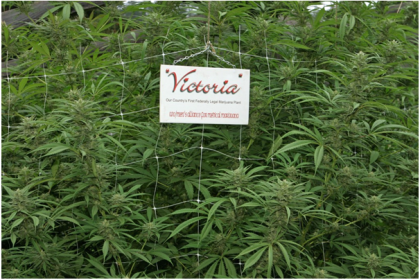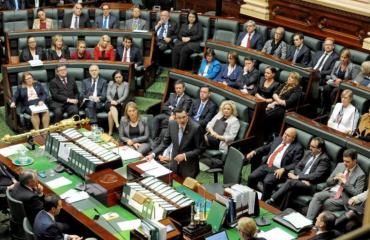
Somewhere in Victoria sits a highly guarded building that will soon become the home of Australia’s first government-sanctioned cannabis crop.
Here, in a research facility shrouded in secrecy, change is coming.
For bio-security reasons, the location of the site remains confidential, but over the next few years, a handful of selected officials will lay the groundwork for a hydroponic scheme that can vastly improve lives.
If all goes according to plan, the state will be growing and distributing its own medicinal cannabis by early 2017, first for about 450 children with severe epilepsy, and eventually, for a range of adults suffering profound pain from diseases such cancer, HIV/AIDS, or multiple sclerosis.
For Premier Daniel Andrews – a former health minister who’s heard countless stories about the relief medical marijuana can bring – it’s a policy no-brainer. But for hundreds of parents, legalising the product also means they will never again be forced to break the law and potentially face criminal sanctions, simply for trying to improve their child’s quality of life.
“No parent should ever have to make that choice,” Andrews said as he unveiled the government’s plans this week. “The time has come for us to stop finding reasons not to do this, and instead drag this law into the 21st century.”
So how exactly will the scheme work? What if the Commonwealth refuses to give it the green light? And how does the government respond to ongoing concerns – not only about the costs or the potential for criminal infiltration, but also claims that its plans are too small in scale and too slow for patients?
“It’s a very timid first step,” says Sex Party crossbencher Fiona Patten, who has been pushing for medical cannabis to be legalised in Victoria for years.
“It’s starting on a very small scale with an incredibly limited number of people, and in the first instance, only to children. But parents are accessing the product right now. They’re all breaking the law right now, and given the 2017 start date, it means that parents are going to continue to break the law for possibly up to two years because they’re not going to stop this life-saving treatment.”
Since Labor announced it would move towards its own medicinal cannabis industry, several major hydroponic tomato growers, tobacco farmers, and private companies have expressed an interest in getting involved.
But Victoria still requires the approval of the Commonwealth, which is a signatory to international rules covering the cultivation and manufacturing of cannabis.
If permission is granted – federal Health Minister Sussan Ley hasn’t ruled it out – the first step involves setting up a cultivation trial to study plant varieties and composition. This, in turn, will pave the way for the initial batch of cannabis products, costing about $50-$58 a month at selected pharmacists, for children whose epilepsy is so profound it can be life threatening.
The thinking is that after a few years, the government-operated scheme would transition into a commercial enterprise, with the Department of Economic Development granting licences to private entities who wish to take part.
Applicants would be subject to criminal record checks and required to prove their premises are secure and safe enough to manufacture the drug for medical purposes, while the chief police commissioner would have the power to veto licences as he saw fit.
It’s a multi-layered process, carefully crafted by the Victorian Law Reform Commission and modelled partly on the scheme that is currently in place for the licensing of alkaloid poppies (there are a handful of cultivation sites around the state, and these too are high-level secrets).
But if it works – and that’s still a big if – Victoria will be the first jurisdiction in Australia to legalise marijuana for medical purposes, setting the template for a potentially significant commercial industry in years to come.
Health Minister Jill Hennessy admits the wait could be frustrating, but told The Sunday Age that “steady, cautious steps” were needed to ensure the state could produce a safe and lasting supply.
The government would also need some time to set up an Office of Medicinal Cannabis – to oversee the manufacturing, dispensing and clinical aspects of the scheme – as well an agreement from the Turnbull government.
“We’re confident that we can make a compelling case to the feds to progress this,” Hennessy said.
“[But] we can’t go from having had nothing in place to having a scheme that serves the medical needs of a diverse range of patient groups overnight … We’ve got to start on a small scale before we can scale up.”
Others, however, are not entirely convinced. Opposition health spokeswoman Mary Wooldridge questioned the price tag, pointing out that “Daniel Andrews is good at the publicity but terrible on the detail, so he needs to work out how much this scheme will cost and who is going to pay for it?”
Meanwhile, Patten has called for the government and police to stop pursuing anyone who administers or uses cannabis products so patients can have some certainty between now and the first batch in 2017.
It’s a valid point – but so far the government hasn’t made any commitments. As for the unknown cost, Andrews argues the investment is worth it, pointing to children like Cooper Wallace, a four-year-old boy who probably wouldn’t be alive today if his parents hadn’t discovered medical cannabis to treat his epilepsy and spasms.
“If you saw him before, he was wasting away,” Cooper’s mother Cassie Batten said last week. “He couldn’t lift his head, he couldn’t move, he couldn’t eat or drink. He’s doing all of that now.”



